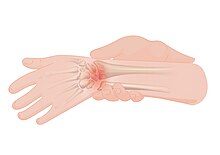
Back Pyn Afrikaans ألم Arabic বিষ Assamese Dolor AST Ağrı Azerbaijani آغری (درد) AZB Skausmos BAT-SMG Kulog BCL Боль Byelorussian Боль BE-X-OLD
| Pain | |
|---|---|
 | |
| An illustration of wrist pain | |
| Specialty | Neurology Pain medicine |
| Symptoms | Unpleasant sensory and emotional sensations[1] |
| Duration | Typically depends on the cause |
| Types | Physical, psychological, psychogenic |
| Medication | Analgesic |
Pain is a distressing feeling often caused by intense or damaging stimuli. The International Association for the Study of Pain defines pain as "an unpleasant sensory and emotional experience associated with, or resembling that associated with, actual or potential tissue damage."[1]
Pain motivates organisms to withdraw from damaging situations, to protect a damaged body part while it heals, and to avoid similar experiences in the future.[2] Most pain resolves once the noxious stimulus is removed and the body has healed, but it may persist despite removal of the stimulus and apparent healing of the body. Sometimes pain arises in the absence of any detectable stimulus, damage or disease.[3]
Pain is the most common reason for physician consultation in most developed countries.[4][5] It is a major symptom in many medical conditions, and can interfere with a person's quality of life and general functioning.[6] People in pain experience impaired concentration, working memory, mental flexibility, problem solving and information processing speed, and are more likely to experience irritability, depression and anxiety.
Simple pain medications are useful in 20% to 70% of cases.[7] Psychological factors such as social support, cognitive behavioral therapy, excitement, or distraction can affect pain's intensity or unpleasantness.[8][9]
- ^ a b Raja SN, Carr DB, Cohen M, Finnerup NB, Flor H, Gibson S, et al. (September 2020). "The revised International Association for the Study of Pain definition of pain: concepts, challenges, and compromises". Pain. 161 (9): 1976–1982. doi:10.1097/j.pain.0000000000001939. PMC 7680716. PMID 32694387.
- ^ Cervero F (2012). Understanding Pain : Exploring the Perception of Pain. Cambridge, Mass.: MIT Press. pp. Chapter 1. ISBN 9780262305433. OCLC 809043366.
- ^ Raj PP (2007). "Taxonomy and classification of pain". In: The Handbook of Chronic Pain. Nova Biomedical Books. ISBN 9781600210440. Archived from the original on 30 March 2021. Retrieved 3 February 2016.
- ^ Debono DJ, Hoeksema LJ, Hobbs RD (August 2013). "Caring for patients with chronic pain: pearls and pitfalls". The Journal of the American Osteopathic Association. 113 (8): 620–7. doi:10.7556/jaoa.2013.023. PMID 23918913.
- ^ Turk DC, Dworkin RH (2004). "What should be the core outcomes in chronic pain clinical trials?". Arthritis Research & Therapy. 6 (4): 151–4. doi:10.1186/ar1196. PMC 464897. PMID 15225358.
- ^ Breivik H, Borchgrevink PC, Allen SM, Rosseland LA, Romundstad L, Hals EK, Kvarstein G, Stubhaug A (July 2008). "Assessment of pain". British Journal of Anaesthesia. 101 (1): 17–24. doi:10.1093/bja/aen103. PMID 18487245.
- ^ Moore RA, Wiffen PJ, Derry S, Maguire T, Roy YM, Tyrrell L (November 2015). "Non-prescription (OTC) oral analgesics for acute pain – an overview of Cochrane reviews". The Cochrane Database of Systematic Reviews. 11 (11): CD010794. doi:10.1002/14651858.CD010794.pub2. PMC 6485506. PMID 26544675.
- ^ Eisenberger NI, Lieberman M (2005). "Why it hurts to be left out: The neurocognitive overlap between physical and social pain". In Williams KD (ed.). The Social Outcast: Ostracism, Social Exclusion, Rejection, & Bullying (Sydney Symposium of Social Psychology). East Sussex: Psychology Press. p. 210. ISBN 9781841694245.
- ^ Garland EL, Brintz CE, Hanley AW, Roseen EJ, Atchley RM, Gaylord SA, et al. (January 2020). "Mind-Body Therapies for Opioid-Treated Pain: A Systematic Review and Meta-analysis". JAMA Internal Medicine. 180 (1): 91–105. doi:10.1001/jamainternmed.2019.4917. PMC 6830441. PMID 31682676.
© MMXXIII Rich X Search. We shall prevail. All rights reserved. Rich X Search